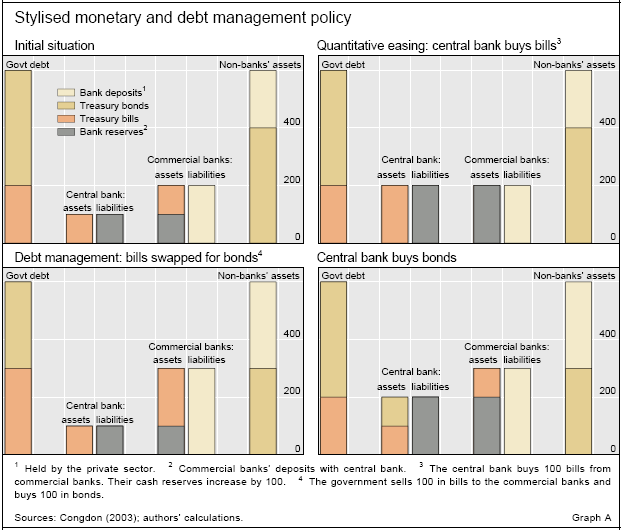Bond buying and debt management: a quantitative view
(Extract from pages 37-38 of BIS Quarterly Review, June 2009)
Following Congdon (2003), this box simplifies the economy's balance sheet to show the quantitative differences among various operations that can be carried out at very low interest rates. The upshot is that a central bank's purchase of government bonds can be seen as a compound of quantitative easing, defined as the central bank injecting funds into the banking system, and a debt management exchange of treasury bills for treasury bonds. This graphical "T-account" exercise is consistent with King's (2009) emphasis on the purchase of gilts from the "wider economy", and not just banks, as well as the Bank of England's purchase of gilts of five to 25 years' residual maturity, usually held by non-banks.
In the initial situation (Graph A, top left-hand panel), the government has a mix of bill and bond liabilities. The bills are held by the central bank and the commercial banking system. The non-bank private sector holds bonds and deposits in the banking system. Cash holdings are abstracted away, so that bank deposits comprise the stock of money. The corporate and household sectors as borrowers from banks and issuers of bonds are also abstracted away.
In this simple schema, one can represent quantitative easing as an operation between the central bank and the commercial banking system (Graph A, upper right-hand panel). The central bank buys treasury bills with its liabilities, and bank reserves increase. Not much happens: the banks hold fewer treasury bills paying essentially no interest but more similarly unremunerative bank reserves. This simplifies the Bank of Japan’s operations, which used a wide set of instruments and counterparties, and the range of holders of bank reserves (which included holdings of foreign banks that had swapped dollars for yen), but it captures the disconnect between rapid growth of bank reserves and muted growth of the money supply that was observed in Japan.
A debt management operation can in principle have greater effect, at least in this simple financial system (Graph A, bottom left-hand panel). The Treasury sells bills to commercial banks and buys bonds from non-bank investors with the proceeds. The non-bank private sector holds less risky treasury bonds and more bank deposits (more money). (Bank reserves are assumed to be a non-binding constraint.)
A central bank that buys treasury bonds basically combines these two operations (bottom right-hand panel). The central bank credits the bank of the seller of the bond with bank reserves, and the bank credits the non-bank investor with a deposit. Money holdings increase, as with the debt swap of bills for bonds, but banks hold more excess bank reserves rather than bills.
In the real world, the results in this simplified financial system may not follow through. The non-bank private sector has in fact borrowed from the commercial banks. Thus, purchases of government bonds by the government or central bank might finance non-banks' repayment of such bank debt rather than boosting broad money (UK House of Commons (2009)). (In particular, an institutional investor might sell a government bond and purchase a newly issued corporate bond, and the issuer might repay a bank loan.) Finally, even if broad money can be increased, it is not clear that would necessarily increase spending by firms and households.

